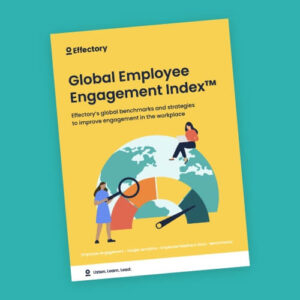Reciprocity is a fundamental principle of social life. It applies intrinsically to almost every relationship from the home to the office and those in between (with the exception perhaps of the very young, sick or old). The basis of creating a highly engaged workplace starts with understanding what your employees need in order to feel motivated and inspired to give their best. This second part of a series on The Global Employee Engagement Index™ explains the four pillars of employee engagement.
Understanding the four pillars of employee engagement

Employee engagement goes both ways
While many organizations are doing an excellent job at meeting those demands, the global engagement figures reveal that there’s still plenty of room for improvement. Engagement and commitment levels worldwide are still less than 30%*.
The benefits of employee engagement
The norm of reciprocity has been studied across psychological, philosophical and social science perspectives for over six decades. It is this concept that regulates the exchanges of goods and services between people in group or individual relationships. It is so intrinsic that we hardly need to reference studies for proof: reciprocity dictates people should help those who have helped them, and equally not harm those who have helped them.
Global Employee Engagement Index™
Discover the Global Employee Engagement Index™ 2025 for key insights on driving employee engagement, improving performance, and enhancing team dynamics.
DownloadThis makes logical sense. So how then does it apply to employee engagement and creating a performance environment within your organization? We know that connected tech, generational differences, and changes in workforce composition have impacted what employees expect from their workplace. The foundation of a reciprocal relationship with your employees begins with understanding those needs.
So, our data analysts set out to investigate this by analyzing the factors at work that uncover what employees believe they need to feel energised and enthusiastic. The results form the Global Employee Engagement Index™, from which the four pillars of employee engagement can be defined.
Four pillars of employee engagement
1. Employees seek a compelling company culture where they feel they fit in, are appreciated, and are proud of what the organization stands for and does. Today – more than ever – company culture is fundamental to business success. Not only does it influence a company’s reputation, but it also plays an essential role in the attracting and retaining talent. To stay competitive, companies need the best people and to have the best people they need engaging company cultures.
Effectory’s global survey focuses on three measurable outcomes:
- How proud employees are of their organization: around one quarter of employees worldwide are extremely proud of their organization.
- Employees’ fit with company culture: three quarters of employees globally feel a cultural fit with their organization.
- Appreciation: one fifth of employees around the world feel that their work is noticed and appreciated within the organization.
2. Employees seek an optimal work environment where they feel enabled to fulfill their role, and develop their skills. Creating this kind of environment has benefits for both the employer and the employee. For the employer the added value is that employees become more engaged in and dedicated to their work. The better engaged an employee is at their job, the better it is for business. For employees, an optimal environment creates more enjoyment while working and offers more scope for personal and professional development.
The Index shows that optimal work environments enable:
- The freedom to work and perform: at present, 23% of employees globally report that they have the full freedom to their job and perform.
- A focus on talent: around 70% of employees globally see a good fit between their talents and the work they do on a daily basis, while 1 in 5 employees experience a perfect fit.
- Opportunities for development: 46% of employees globally feel they do not have enough opportunities to grow and develop professionally at work.
3. When it comes to leadership, employees seek exceptional leaders at C-suite level who inspire confidence, keep up-to-date with current affairs, and communicate. While the C-suite are important for business (without a properly functioning C-level, the organization would struggle), they also impact employee engagement and commitment levels.
Exceptional leaders are able to enhance the interest of their employees, improve the meaningfulness of the work, influence organizational commitment, encourage intrinsic motivation, and help employees succeed in their careers.
Our gloabl survey looks into:
- Employee confidence in C-suite: globally just 14% of employees have complete confidence in the leaders of their organization.
- Communication from the top: a mere12% of employees worldwide think that top-down communication works well.
- How up-to-date and informed C-suite are: globally, only 15% of employees feel that leadership keeps up to date.
4. Employees seek inspiring immediate managers who motivate, use employee feedback, and are proficient in people management. While teams impact an employees’ work experience, our research has shown that immediate managers have an even greater influence on how they experience their work.
Leadership in contemporary workplaces can be observed both on organizational and team levels; therefore, it is crucial to understand the characteristics of a good leader. A good leader is someone who can influence, inspire, motivate, guide, and manage expectations. Leadership style is important since the competency of a leader might influence the bonding and performance of a group strongly.
Our research focuses on the three key areas with regards to immediate managers:
- Motivation: over the last two years immediate managers have gotten better at motivating employees, with one in five employees reporting that they feel their manager highly motivates them.
- Feedback (if managers are open to suggestions, if managers praise employees and if managers discuss improvement points with employees): while over 60% of employees worldwide indicated that their manager is open to suggestions, less than 1 in 5 employees reported receiving regular praise.
- People management: around 70% of employees globally reported a good relationship with their manager.
Combined, these pillars can be used to create a strong foundation within your organization that facilitates productivity, higher levels of performance and commitment and longer tenures. Perhaps what goes down must come up, too.
*About the Global Employee Engagement Index™
The Global Employee Engagement Index™ is an extensive longitudinal employee survey conducted across 56 countries with over 18,000 respondents. Employees answer numerous questions related to engagement including workplace, well-being, alignment to organizational goals, leadership, future intentions and role clarity. It provides a comprehensive benchmark for multinationals and solves the dependency that organizations currently have on reference company benchmarks. It does this by ensuring the data remains accurate and a uniform point of reference for the entire survey journey.
